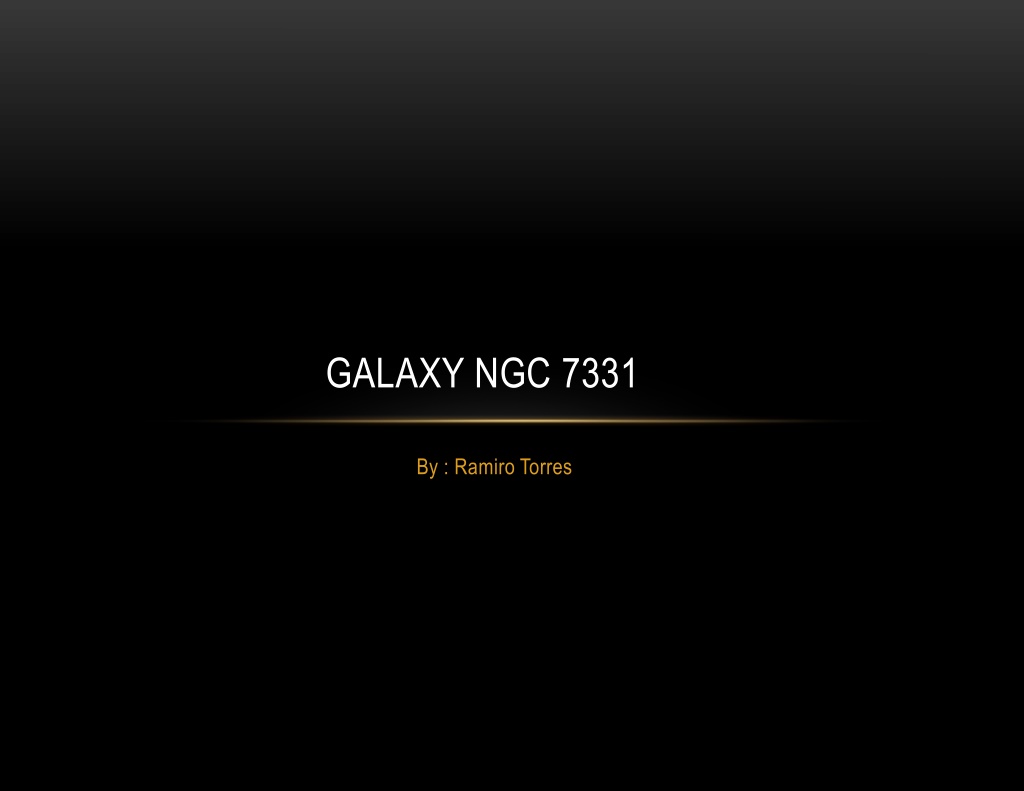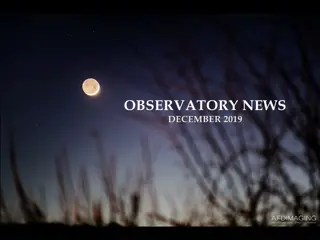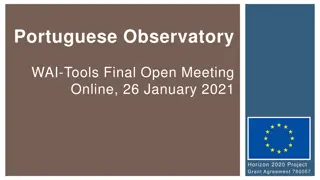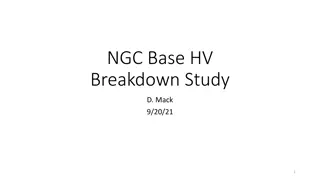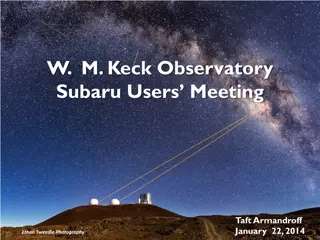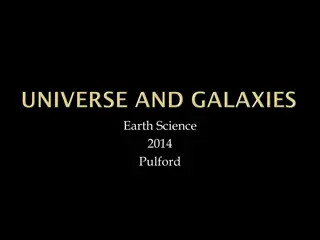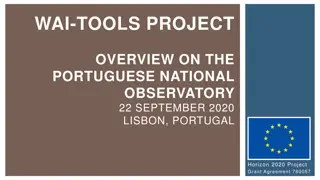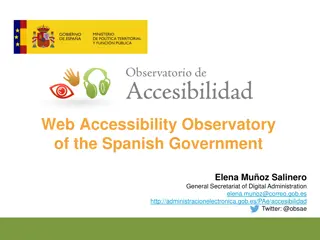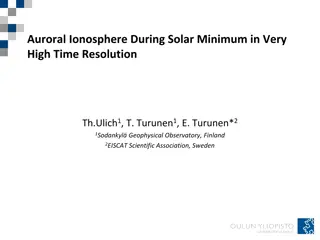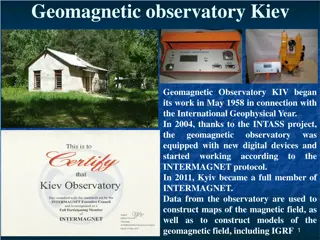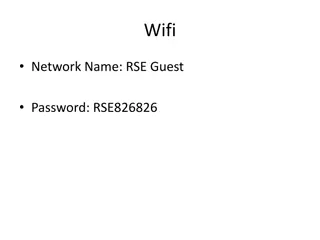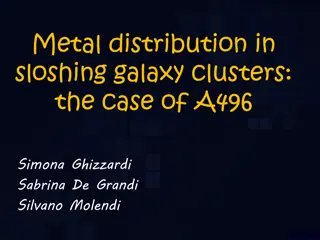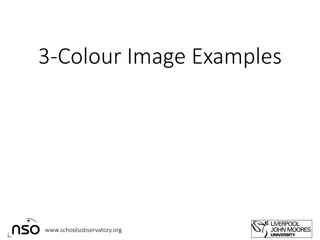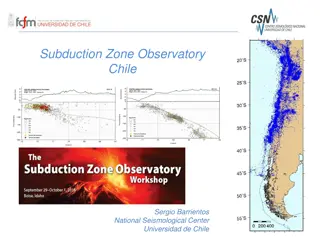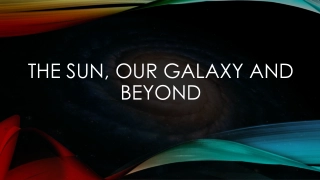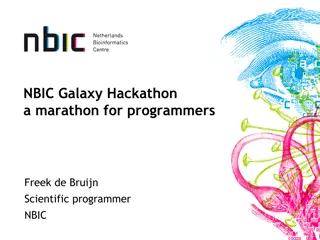Observing Spiral Galaxy NGC 7331 at Texas Tech University Observatory
This project details the observation and imaging of spiral galaxy NGC 7331 by the researcher using equipment at the Texas Tech University observatory. The process involved data gathering over two nights, processing images using CCDSoft and Photoshop, and combining filtered images to produce a final color image. The purpose was to capture the structured spiral arms of NGC 7331, which bears similarity to our Milky Way galaxy. The project aimed to obtain a color image of this intriguing celestial object.
Download Presentation

Please find below an Image/Link to download the presentation.
The content on the website is provided AS IS for your information and personal use only. It may not be sold, licensed, or shared on other websites without obtaining consent from the author. Download presentation by click this link. If you encounter any issues during the download, it is possible that the publisher has removed the file from their server.
E N D
Presentation Transcript
GALAXY NGC 7331 By : Ramiro Torres
INTRODUCTION: My discussion will cover the following: Brief description of the project. Object of Observation. How was the data gathered? What was the process taken to complete the project? Result
PURPOSE OF PROJECT: The purpose for the project is to image an object in the sky using the equipment on the Texas Tech University observatory. To process the images obtained using two very useful programs: CCDSoft & Photoshop. The final goal is to obtain a color image.
REASON TO PICK SPIRAL GALAXY, NGC 7331: I decided to image a spiral galaxy for its amazingly structured spiral arms. The major reason is that NGC 7331 has a structure that resembles that of our own galaxy Milky Way.
OBJECT OF OBSERVATION: The object that I decided to image was galaxy NGC 7331 a spiral galaxy, also referred to as Caldwell 30, this galaxy is located in the northern constellation Pegasus. NGC 7331 is the brightest member in the Deer Lick Group. It was firstly discovered by William Herschel in 1784. The distance to NGC 7331 is 12 Mpc, with a diameter of 106light years. It is estimated to be receding from us at a velocity of 816 km/s. This galaxy appears to have companion galaxies: NGC 7335 and NGC 7337 near to it, however these companions are estimated to be 10 times more distant. Their alignment with galaxy 7331 occurs by coincidence.
DATA GATHERING: The images were collected over two nights: 2.5 hours in the first night and 1 hour for the second night. Clear: 3 minutes x 20 images. Utilized a 20 Planewave-Cassegrain Telescope with CCD STL-1001E. The images that are to be used: flats, flat darks, and darks, were taken prior to imaging color. Images were taken using red, green, blue, and clear filters. Exposures : Red: 3 minutes x 15 images. Green: 3 minutes x 15 images. Blue: 3 minutes x 15 images.
PROGRAMS & PROCESS UTILIZED TO PROCESS IMAGE: Two Programs were utilized to process the images for the object: CCDSoft and Photoshop. CCDSoft is used for-- Calibrate (done for each filter separately): darks--subtract the noise from the images, flats used to flatten the background of image for each filter, and dark flats subtract the noise from flat images. Align aligning all the images, used to align all filtered images together. Combine (done for each filter separately)- combining every image. Photoshop: Provided the tools levels, curves to improve the appearance of each image. As well, the tools to combine the filtered images, into a single color image and finally to combine the color picture with clear filtered image to produce final result.
IMAGES THROUGHOUT PROCESS: Filtered Images (starting from left): Blue, Clear, Green , and Red. Their appearance was improved using levels, and curves from photoshop. After using CCDSoft for: calibration, alignment, and combining. Blue Clear Green Red
IMAGES THROUGHOUT PROCESS (CONTINUED) The color filtered images have now been combined into one. At this point, levels and curves were used to balance the color in the image. Next, it will be combined with clear filtered to bring out the detail from galaxy.
IDENTIFYING THE GALAXYS NEIGHBORS: NGC 7335 NGC 7331 NGC 7337
SOURCES: Listed are all the sources I used to gather background information regarding the galaxy I decided to image: http://annesastronomynews.com/photo-gallery-ii/galaxies-clusters/ngc-7331-by-robert-gendler/ http://www.lvastronomy.com/observing-challenge/97-september-ngc-7331-caldwell-30-galaxy-in- pegasus http://www.kopernik.org/images/archive/n7331.htm
